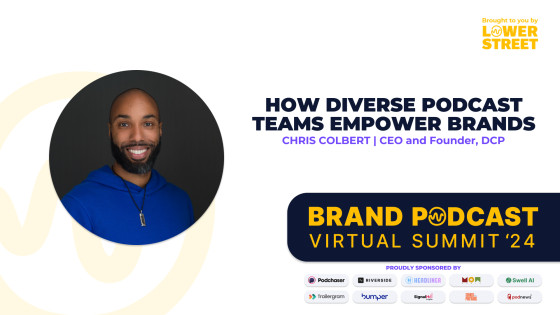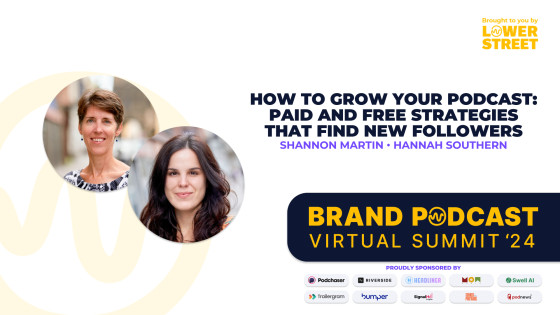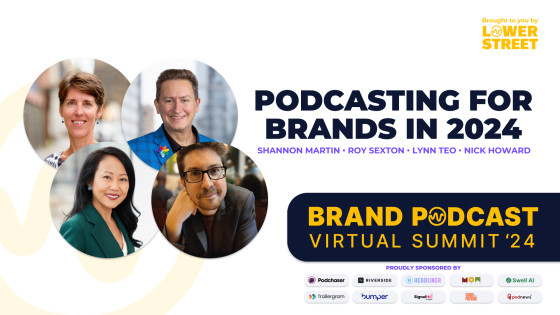The Meta of Brand Podcasting: Why Your Look and Sound Matter More Than You Think
Contents

Ever walked into a café, looked around, and immediately gotten a little judgy about the vibe? That’s exactly what happens when someone stumbles upon your podcast. The artwork, the name, and the sound—it all comes together to let your listeners know if this is a show they want to keep tuning in to. And if one of these is off? Well, they’re going to scroll on to the next one.
At the Brand Podcast Summit, we had two sessions that really brought to light just how important these issues are: Podcast Artwork Best Practices with Good Tape Studio, and Why Your Podcast Needs Better Sound with audio experts from Lower Street, Square Wave Sound and The New York Times.
Here’s what we learned.
Podcast Artwork Best Practices: Your Guide to Standing Out
That little square of your podcast artwork can determine whether they hit play or scroll past. Strong artwork gives listeners an instant feel for your show’s vibe. With so many shows pining for attention, your artwork has to put in the work.
Great artwork builds curiosity, reflects the tone of your show, and speaks to your target audience. It’s about making sure people instantly “get” what your podcast is about. Whether your show is funny, serious, or educational—your design must communicate that in a split second.
Laying the Groundwork: Start with a Solid Brief
Before jumping into designs, start with a clear direction. A strong design brief acts as the foundation for effective artwork. Whether you’re working with a design team or tackling it yourself, here’s what you want to think about:
Podcast Title: Short and snappy works best—aim for 20-30 characters. Keep punctuation, capitalization, and word order consistent across platforms.
Show Vibe: Is it lighthearted? Serious? Energetic? Write down the emotions and themes you want your audience to feel.
Audience Focus: Who are you talking to? Define your ideal listener.
References: Look beyond other podcast covers. Pull inspiration from cultural or visual elements tied to your show’s identity.
Must-Haves: Decide upfront if you need things like logos, subtitles, or host names on the tile.
Deliverables: Beyond the main tile, what other assets might you need? Banner images, promotional graphics, or templates?
The more specific you are during this planning stage, the better your end result will be.
Tips for Designing Eye-Catching Podcast Artwork
Keep Titles Short and Legible: You don’t have much space to work with. A cluttered design or long title can be confusing. Stick with short, bold font choices that work well even at tiny sizes. Contrast is going to be your friend.
Think About Tone and Personality: Your artwork needs to reflect the tone of your podcast. For example, a serious news podcast might lean on structured, minimalist designs. On the flip side, a comedy show might use playful colors and quirky fonts.
Include Essential Details: Stick to the must-haves: the podcast title, any necessary logos, and—if relevant—a host photo or graphic to showcase the theme. Avoid overloading your design with text or unnecessary elements that compete for attention.
Use Creative Visuals: Abstract illustrations, symbolic icons, or bold graphics can all make a podcast tile stand out. But steer clear of generic stock images or overused styles. This is your chance to show off what makes you, you!
Tie the Imagery to Your Show: For example, if you run a sports recap podcast, incorporating visual elements like jerseys or game scenarios can make the purpose immediately clear.
Consider All Your Podcast Graphics
Your podcast is more than just the artwork. To really establish a recognizable look and feel, you’ll need a variety of other branded assets
Episodic Artwork: Create a custom image for each episode—especially if your show features individual guests or specific topics. This can tie back to your main tile but provide enough variance to highlight weekly content.
Promotional Banners: Platforms like Apple Podcasts often request hero banners or full-page promotional artwork. Invest the time to create banners that align with your tile for consistent branding across the board.
Social Media Graphics: Think profile photos, story templates, and branded posts to support promotion online.
YouTube Thumbnails: If your podcast appears on YouTube, creating thumbnails that work in a 16x9 format ensures a seamless presence there, too.
Every design element should feel like part of a cohesive brand.
Rebranding an Existing Podcast
Already launched but feel your artwork needs an update? Don’t stress—listeners are surprisingly adaptable to change. Here’s how to handle a refresh without losing the trust you’ve built:
Be Strategic: Maintain some key design elements from your original branding (like colors or fonts) for continuity.
Communicate Ahead of Time: Let your audience know about the upcoming change. Announce the refresh in an episode or on social media—get them excited!
Think of It as a Relaunch: Use the redesign as an opportunity to promote your show again. Fresh artwork can draw in new eyes and reignite interest from current subscribers.
Now You’ve Got The Look, How Do You Sound?
Audio quality is the foundation of your listeners’ experience. Great artwork gets them to press play, and great audio (and content) keeps them sticking around.
At the Brand Podcast Summit, we heard from Lower Street’s Alex Bennett, Square Wave Sound’s Mark Angly, and The New York Times’ Marion Lozano on Why Your Podcast Needs Better Sound. They shared exactly why sound quality matters, how it connects emotionally with your audience, and offered practical advice to polish up your show.
Here’s what we learned from them.
Why Sound Quality Is More Than a “Nice-to-Have”
Studies show poor audio quality can make your podcast feel less trustworthy to listeners. If the sound is unclear or poorly balanced, people struggle to focus. And honestly, it's going to make them tune out entirely.
Quality sound design is also your tool to bring your podcast to life. It gives you the power to make your story fully immersive. From subtle sound effects to atmospheric music, sound design carries emotional weight for your audience.
Experienced sound designers insist that sound effects and music aren’t there to distract but to complement and enhance the narrative. The goal? Engage listeners deeply without them even realizing how much work went into it.
If we’re talking branded podcasts, your podcast is an extension of your brand’s values. So don’t you want to sound polished? Show you are professional, show you know what you are doing.
Getting the basics right—clarity, levels, and consistency—isn't optional.
The Basics of Great Podcast Audio
Keep Levels Balanced
One of the biggest mistakes in podcasting is uneven audio levels. Imagine turning up the volume to hear a soft section only to get blasted by the next one. Not fun, right?
Mark Angly of Square Wave Sound explained that clarity and consistency are essential. “It’s so important that listeners don’t have to fight to hear what’s being said, especially in noisy listening environments like cars.”
Crisp Clarity Is Key
Clarity in audio is like good lighting in photography. You may not notice when it’s good, but you’ll definitely notice when it’s bad. Clarity is built by several factors: proper microphone use, soundproofing, post-production cleanup, and reducing noise.
In its simplest form, the rule is: if your listeners can’t clearly understand what’s being said, they’ll stop listening.
Tools to Transform Your Audio
Sound design doesn’t always mean doing it all from scratch. Editing, mixing and mastering need a great sound designer. But to layer immersive elements, you don’t need to head out with a mic and get all your sounds. Here’s some tools to give you a leg up in your sound design.
Music Libraries
Background music adds mood and fills moments of transition in your podcast.
Artlist: A massive catalog with everything from cinematic scores to upbeat jingles.
Soundstripe: Smaller but carefully curated, perfect for high-quality creations.
APM Music: A go-to for finding super-specific tracks across a wide spectrum of genres—though it’s pricier.
You can check out any royalty-free music platforms to gather sounds and music.Some may require a little fee, others have good free options.
Sound Effects
A little subtle touch like footsteps, nature sounds, or ambient chat can really improve your show. Sound effect libraries like Soundly or SoundSnap give you quick access to thousands of effects. If you really need something unique, you can record your own Foley sounds on a basic microphone.
Plugins for Post-Production
Cleaning up your audio can be made a lot easier with the right plugins. Simple tools like EQ and compression can do wonders for boosting clarity and cutting distracting noise. Popular plugin suites include:
FabFilter Pro Bundle for advanced leveling and equalizing.
Soundtoys for exploring fun, creative tweaks to your audio.
What About AI-Enhanced Tools for Audio?
Every editing and recording platform will offer an AI-powered audio clean-up tool. Some work better than others, iZotope RX has become popular for cleaning up audio with background noise or flawed recordings. When used sparingly, they can be lifesavers.
But, experienced producers warn against overusing them. AI tools might strip away too much texture, making your podcast sound sterile or flat. Sometimes, the raw quality of a room—like the ticking of a grandfather clock in the background of an interview—adds authenticity and depth to your story.
Do your best to get a quality recording from the get-go, then use AI tools only as a last resort to fix when needed.
Your Steps to Better Sound
If you are just stepping into podcasting, or if you’re working on transforming your current show, here’s some steps to improve your audio:
Invest in a Decent Microphone: Even a budget-friendly one can be a huge upgrade from your laptop mic. We often recommend the Samson Q2 or Shure MV7+ Microphone Bundle.
Record in Quiet Spaces: Minimize echoes and background noise to reduce post-production effort.
Balance Your Levels: Use basic EQ and compression tools to keep your audio even.
Add Music or Effects Sparingly: Keep it subtle and intentionally placed to enhance, not overpower.
Experiment with Sound Libraries: Play around with different music or effects until you find what works.
Further Reading: How to Edit a Podcast
Ready to Upgrade your Show?
Even if you have a show out already, you can always work on tweaking your artwork and sound design to improve your show. Better artwork can bring you more attention and more listeners ready to press play. While clear, and engaging audio can get audiences to tune in longer and keep coming back.
Want to hear more? Check out all the Brand Podcast Summit Replays here.
Ready to start your own podcast?
If you need help creating your branded podcast, contact us today to get started.
Get in touch




